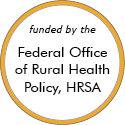Rural Project Examples: Healthcare needs and services
Other Project Examples
Optimal Health Behavioral Health Home Models
Updated/reviewed December 2019
- Need: A healthcare delivery model to improve health and well-being of Pennsylvania patients with serious mental illness in Pennsylvania, especially those in rural settings.
- Intervention: County human service administrators, patients, families, a behavioral health provider network, and a nonprofit behavioral health managed care organization implemented 2 versions of a behavioral home health model focusing on a complete culture of wellness.
- Results: These unique models significantly increased patient activation, engagement in both primary and specialty care, and improved client perception of their mental health status.
Ohio Northern University's HealthWise Mobile Outreach Program

Updated/reviewed July 2019
- Need: Meeting both advanced practice pharmacy student education needs and patient healthcare needs in a nearby rural/underserved area.
- Intervention: With support from multiple organizations, students in the Ohio Northern University's College of Pharmacy program use a motor coach to deliver a wide range of healthcare services during scheduled outreach visits.
- Results: In the program's first two years, point-of-care screening, immunizations, and chronic disease prevention and management education have been provided to 800+ Hardin County, Ohio, residents.
The Adolescent Pre-Diabetes Prevention Program

Added October 2018
- Need: Prevention of type 2 diabetes in adolescents living in rural parts of Louisiana.
- Intervention: Through screenings, the Adolescent Pre-Diabetes Prevention Program detects the onset of prediabetes. Through nutrition and physical activity education, the program teaches high school students and staff how to adopt healthy lifestyles.
- Results: The program has seen an increase in enrollment and continues to see decreases in body weight, body mass index, and A1C levels among participants.
For examples from other sources, see:
